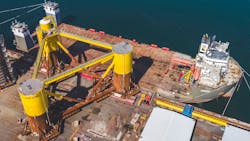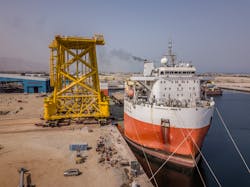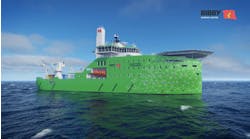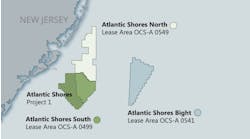By Francisco Rodrigues, Mammoet
Ambitious targets for expanding the world’s offshore wind capabilities are driving developers to seek the greater energy generation potential that lies in deeper waters of more than 60 m. But existing fixed-bottom turbines are not economically competitive at these depths, which has led to burgeoning interest in floating turbine technology and how this can be scaled commercially.
The significant differences in the dimensions and subsea structure of floating turbines mean that many of the challenges in delivering them on a global scale relate to the logistics involved and the changes in methodologies that must be made.
So, how can engineered heavy lifting and logistics help this technology mature and realize its potential?
Perhaps the most critical difference between fixed-bottom and floating turbines is the foundations, which are far bigger for floating developments and weigh thousands of tonnes—sometimes more than 10,000. So, although the manufacturing process remains like that used for fixed-bottom turbines for everything above water, the sheer size of each floating foundation will mean huge changes to its supply chain, logistics and launch. Clearly, storing foundations that can measure 100 sq m on land will not be a viable long-term option, and it will mean that manufacture and logistics must go hand-in-hand.
There is also the task of managing the load-out of these huge structures, akin to the demands seen during modularized projects for the petrochemical sector. The industry will need to look beyond Europe to locations such as Southeast Asia, China and the Middle East to make best use of the facilities available. Using multiple fabricators in several locations will allow more of each project to be undertaken in parallel and by specialist facilities (e.g., shortening the schedule of projects and therefore increasing cost-effectiveness). This, in turn, will increase the viability of projects and allow more of them to move forward.
When fabrication of the foundations is complete and it’s time to get them in the water, there are further challenges. For one, this must be achieved for the most part without the use of dry docks, as the majority of these will be unsuitable for objects of this size. Ports of a suitable draft are also needed, typically about 12 m or more.
Launch strategies
With weights of anything between 3,000 t and 16,000 t, the launch of floating foundations is far from simple, the key challenge being to find a safe, cost-efficient and scalable method for placing large units in the water. Choosing the right partner to handle lifting and load-out operations will be crucial if developers are to best manage risk and increase the cost-effectiveness of projects without being tied to one region. Luckily, the expertise that has been used in the past to load-out oil and gas modules of more than 40,000 t can be re-deployed to match the needs of floating wind, as foundations grow ever-larger.
To date, a range of different solutions have been used to perform launching and one common approach has been the use of semisubmersible vessels. But there are questions over whether enough vessels will be available to meet demand, and whether they will be cost-effective when hired over a long period of time, during which they will be idle for long periods.
So, what are the solutions for projects where this is not a viable option? Mammoet has found that moving foundations directly into the water is the most effective method of launching, as opposed to the use of transition equipment such as a floating platform. A promising methodology is to use a hybrid approach, whereby the floater is lifted from both land and sea and lowered onto the water directly at the quayside.
Utilizing cranes
This is made possible by new generations of cranes capable of lifting the thousands of tonnes necessary and offers several advantages. As components are placed directly into the water right next to the quay, the process takes less time and is therefore less costly and requires less auxiliary equipment—generally needing only commonly available grades of barges. The combination of lifting capacity and reach means that these huge cranes can both lift floating foundations directly into the water and assemble the turbines from one position.
Using large cranes can also be preferable during the assembly phase. Jackup vessels may be too short to assemble turbine sections in deep drafts, while using crane vessels increases the complexity of assembly engineering, as transfer is needed between two floating objects.
Collaboration across the supply chain will be key to establishing the most efficient methods of getting floating wind developments online. But a combination of vast relevant experience built in other sectors of the energy industry, as well as technical innovations and new equipment, means that the heavy lifting and logistics scope of these projects is starting to mature.
About the author: Based in Portugal, Francisco Rodrigues has been Mammoet's global segment lead for offshore wind since 2020.
02.16.2023




